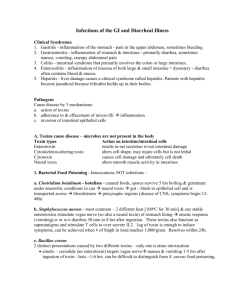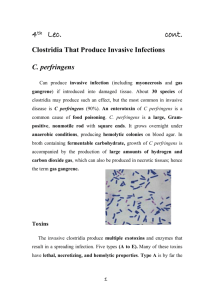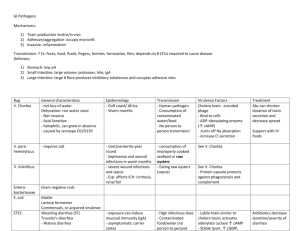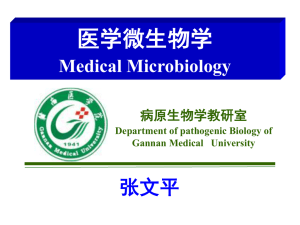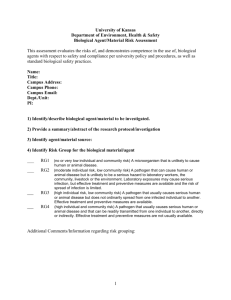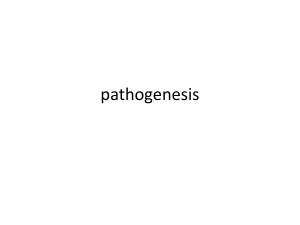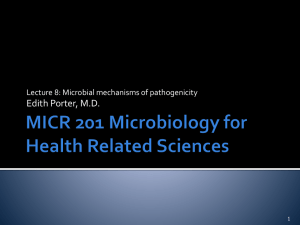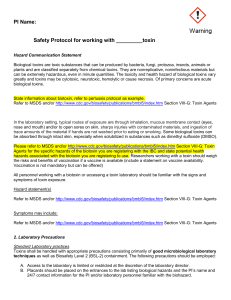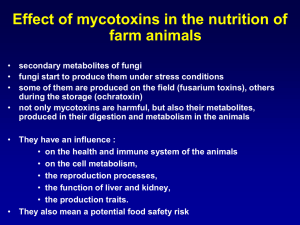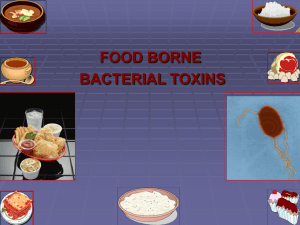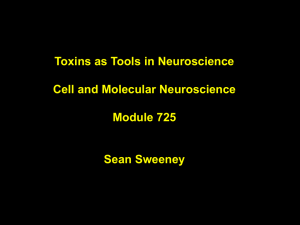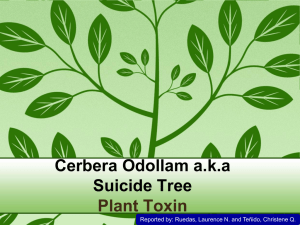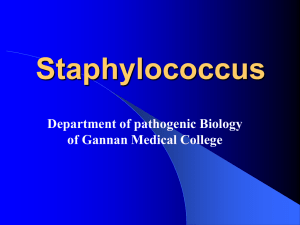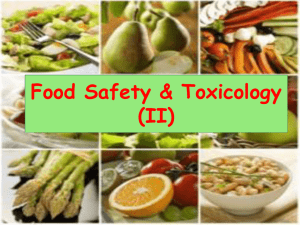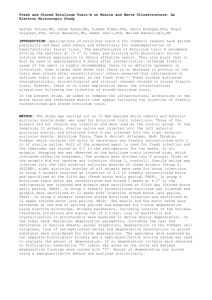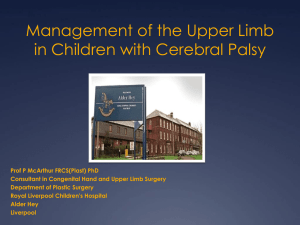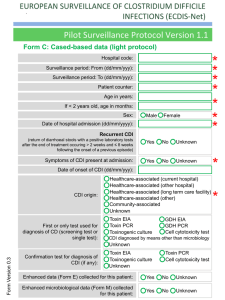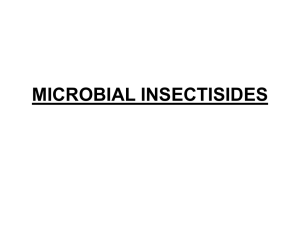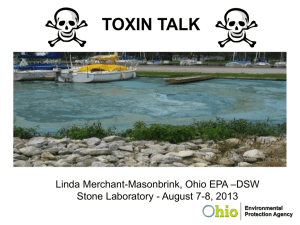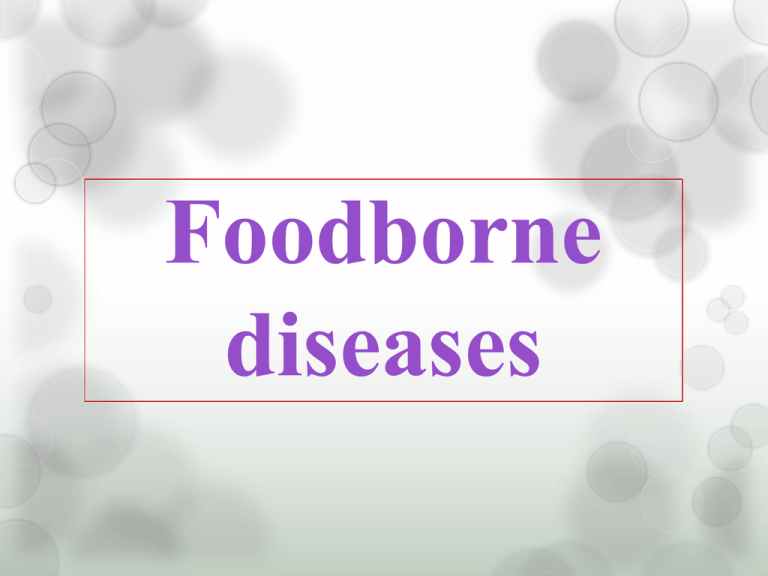
Foodborne
diseases
Food poisoning:
Gastrointestinal illness caused by
consumption of food contaminated with
bacteria, fungi, parasites, viruses, bacterial or
fungal toxins or chemicals.
• In 2010, Public health workers (Foodborne
diseases active surveillance Network
(Food-Net)) estimate approx. 1000
outbreaks, 48 million illnesses, 128,000
hospitalization, and 3000 deaths annually
due to foodborne illness in USA.
N
Foodborne disease outbreak:
Gastrointestinal illness of two or more
persons who experience similar symptoms
due to ingestion of contaminated food or
water confirmed by epidemiological analysis
results.
Types of Food Poisoning:
• Intoxication.
• Food poisoning caused by microbial entry.
N
Food poisoning caused by microbial entry:
• Due to ingestion of food contaminated by
microbes or microbes and their toxins.
• Caused by Vibrio species, ETEC, EPEC,
Salmonella, Campylobacter, and others.
• This type is mainly characterized by
longer incubation period than intoxication,
fever, and lower gastrointestinal
symptoms.
Food poisoning Due to intoxication
•
Ingestion of food contaminated by microbial
toxins.
•
Intoxication is mainly characterized by short
incubation period, upper gastrointestinal
symptoms such as nausea and vomiting.
•
Caused by:
o Staphylococcus aureus,
o Clostridium perfringens,
o Clostridium botulinum,
o Bacillus cereus.
Staphylococcus aureus toxigenic disease:
Implicated food:
Carbohydrate rich food: cake, pasta, potato,
salads.
Protein rich food: beef or pork-meat,
mayonnaise, milk and its products (e.g. icecream).
Source of food contamination:
Usually a carrier persons such as foodhandlers. The organism grows in the food and
produces the toxin.
Incubation period: Very short (1 – 6 hours;
epidemiological clue)
Symptoms: Vomiting, nausea, abdominal
cramps, followed by diarrhea but no fever.
Abdominal pain and inflammation are absent.
Duration of illness: 24 – 48 hrs (self limited).
Types of enterotoxins produced by S. aureus:
• Enterotoxins: A, B, C, D, E, and G.
• Enterotoxin: F & pyrogenic exotoxin c.
Enterotoxins: A, B, C, D, E, and G.
N
o Produced by 65% of Staphylococcus aureus.
o Heat-stable (resist ~30 minutes of boiling 100ᵒC).
o Resistant to hydrolysis by gastric proteases.
o Do not change the food taste, color, or odor.
o Enterotoxin A is the most common. Enterotoxin C
and D are associated with contaminated milk.
o These toxins may cause Watery diarrhea;
dehydration.
o Enterotoxin B is associated with Staphylococcus
pseudomembrance enterocolitis.
N
Enterotoxin F and pyrogenic exotoxin c:
(Toxic-Shock Syndrome toxin-1):
Mainly produced during S. aureus growth in
the GIT. When reached bloodstream, these
toxins will cause sepsis, septic shock, and
multiple organ distress syndrome (MODS).
Diagnosis:
• Clinical: symptoms, history of eating meats
of high salt content or eating high sugar
content food.
• Laboratory Diagnosis:
N
Laboratory Diagnosis:
o Specimens:
Swabs from vomitus and implicated food.
Skin of food-handler, Nasal swabs of carriers.
o Phage typing and biotyping: to confirm the source of
the bacteria.
Bacillus cereus intoxication:
Two presentations: Emetic syndrome or Diarrheal
syndrome
Emetic syndrome: Heat-stable enterotoxins.
-Associated foods: Consumption of toxin in
boiled or fried rice and carbohydrates rich food*.
-Incubation period: Short incubation period of
1-6 hours
-Clinical presentation: Upper gastrointestinal
symptoms such as nausea, vomiting and abdominal
cramps.
-Duration of illness: 6-10 hour.
N
Diarrheal syndrome: Heat-Labile enterotoxins.
- (Stimulate adenylate cyclase-cAMP system).
- Associated foods: consumption of contaminated
meat products, soups, sauces, and vegetables.
- Incubation period: Longer incubation period of
8-16 hours.
- Symptoms and signs: Watery diarrhea,
abdominal cramps and occasional nausea &
vomiting.
-Duration of illness: 24-48 hours.
N
Diagnosis:
-Isolation of microbes from clinical specimens and
food samples(same species identification).
-Phage typing and biotyping.
Clostridium perfringens intoxication:
Implicated food:
-Poultry, meat, pork-meat.
-Spores are present in cooked-meat that not is
refrigerated; spore will germinate due to exposure to
gastric acid and produce it’s toxins.
Types of Toxins: Enterotoxin & exotoxin.
Enterotoxin: Heat-labile: with maximal activity in
ileum. Inhibits glucose and ions transport; damage of
intestinal epithelial cells and loss of protein.
-Effect: Watery diarrhea without nausea or
vomiting.
N
Exotoxins: Alpha-toxin ; lecithinase: Heatstable toxin.
Effects:
•
Disease: Enteritis necroticans: Intestinal
necrosis with bloody diarrhea (only the toxin,
the bacteria is not present)
•
Damage of phospholipids in the cell
membrane causing lysis of RBCs ,WBCs,
platelets, and endothelial cells.
•
If the toxin reach the bloodstream; sepsis and
septic shock; Mortality rate: 40%.
N
Diagnosis of Clostridium perfringens
intoxication:
• Watery diarrhea:
-Positive culture from stool specimens and
implicated food samples; 105 CFU/gm is a
diagnostic feature.
-The enterotoxin can be detected in stool, and antitoxin antibodies can be detected in patient serum.
• Enteritis necroticans:
-Negative stool culture. Antibodies can be detected
in serum in 65-85% of patients.
Clostridium botulinum intoxication: Botulism:
o Implicated food:
Canned food, sausage, canned salmon and salted fish.
o Produced Toxin: Botulinum toxin A,B,C,….G.
Polypeptide, heat-labile (10 minutes at 60 ᵒC).
Has two subunits:
light-A chain: Neurotoxin*.
heavy-B chain: protects the toxin from stomach
acidity. The toxin is also protected from gastric
enzyme by large content of protein in the meal.
o Incubation period: 12-72 hours.
Effect of botulinum toxin:
N
N
Effect of botulinum toxin:
After absorption, circulating neurotoxins affect the
cholinergic nerves function:
Effect on sympathetic nervous system:
Blocking of excitatory acetylcholine release in
neuromuscular junctions; bilateral descending
flaccid paralysis.
Effect on parasympathetic nervous system:
Respiratory paralysis; death.
Effect on cranial nerve function: blurred vision,
fixed dilated pupils.
N
Management:
-Adequate ventilation support.
-Gastric Lavage and Penicillin therapy.
-Trivalent botulinum antitoxin vaccination.
- With good care the mortality rate is decreased to
25%.
Prevention:
-Good heating of food to destroy toxin.
-Storage of food at 4C.
Fungal Intoxication: Mycotoxicosis:
Toxins: Aflatoxins, ergot alkaloids, tricothecene &
ochratoxins:
AflatoxinsB1,B2, G1,G2:
-Produced by Aspergillus flavus.
-Implicated food: Peanuts, Corn, grains.
-Effect: liver necrosis, hepatocarcinogen.
Ergot alkaloids:
-Produced by Claviceps purpurea.
-Implicated food: wheat, corn, rice.
-Effect: Arterial and venous vasoconstriction and
endothelial cell damage. (ergotamine drug)*
Tricothecene:*
N
-Produced by Fusarium species.
-Implicated food: corn, rice, wheat.
-Effect: inhibition of DNA replication and mRNA
transcription in the epithelial lining of GIT and
bone marrow (diarrhea, hypotension, weakness,
bleeding and death)
Ochratoxins A,B,C:
-Produced by Aspergillus species.
-Food: Corn, rice.
-Effect: Destruction of proximal tubules of
kidney; decreased electrolytes absorption, increased
water excretion.


